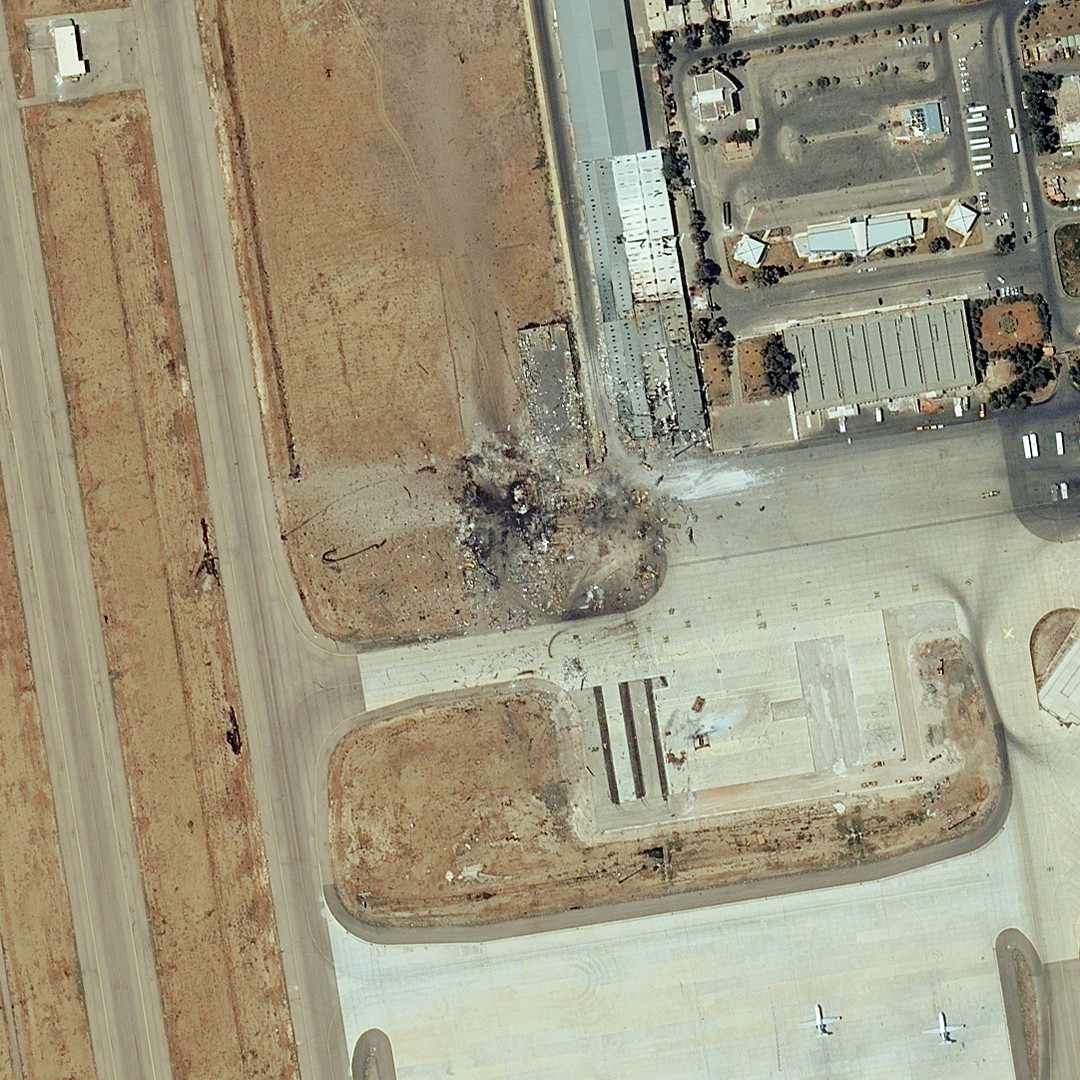
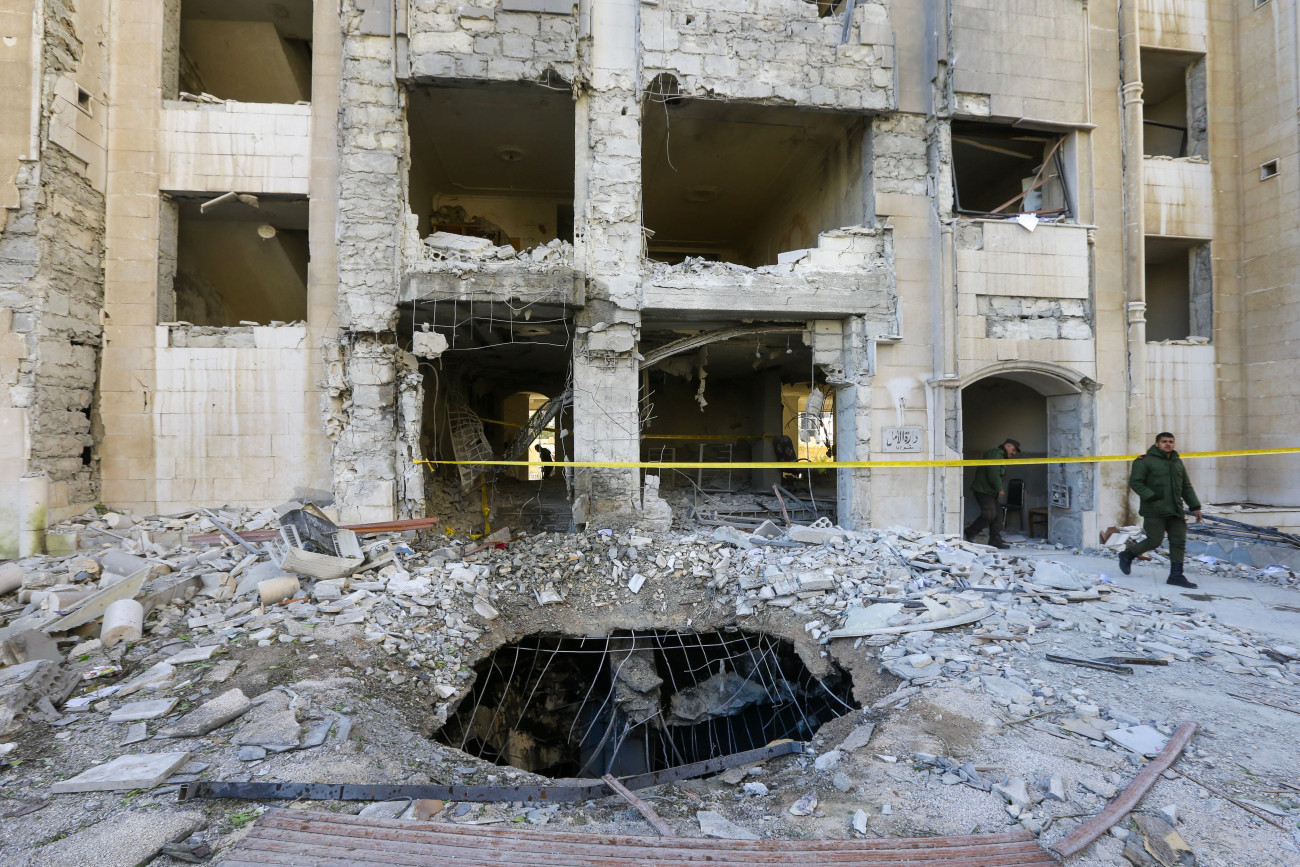
Summary
Since 2013, Syria’s regime-controlled territories have witnessed recurrent Israeli airstrikes targeting Iranian forces and their allied militias’ bases. These strikes articulate Israel’s multifaceted objectives: obstructing the flow of advanced weaponry to Hezbollah, a group significantly backed by Iran in southern Lebanon, and safeguarding its national security by neutralizing perceived threats emanating from Iranian affiliations in Syria.
The following quantitative analysis explores the core of Israel’s strategic airstrikes in Syria between 2013 and August 2023, a critical aspect of its defense policy during this time, aimed at mitigating Iranian influence in the region and protecting its national borders.
Introduction
Over the past few decades, Iran has strategically cultivated a network of allies and proxies across the Middle East, encompassing countries such as Syria, Yemen, Lebanon, and Iraq. This network is designed to bolster Iranian influence and counteract its adversaries, notably the United States and Israel. Iran’s deep-seated involvement in the Syrian conflict has progressively emerged as a significant threat to the U.S. strategy anchored in safeguarding Israel and maintaining its military dominance in the region.
Since 2013, Syria’s regime-controlled territories have witnessed recurrent Israeli airstrikes targeting Iranian forces and their allied militias’ bases. These strikes articulate Israel’s multifaceted objectives: obstructing the flow of advanced weaponry to Hezbollah, a group significantly backed by Iran in southern Lebanon, and safeguarding its national security by neutralizing perceived threats emanating from Iranian affiliations in Syria.
The following quantitative analysis explores the core of Israel’s strategic airstrikes in Syria between 2013 and August 2023, a critical aspect of its defense policy during this time, aimed at mitigating Iranian influence in the region and protecting its national borders.
Objective of the Study
This study is dedicated to examining the publicly reported Israeli strikes directed at Iran in Syria over a decade, spanning from 2013 to mid-2023. The analysis encompasses various dimensions including the volume of targets, the intrinsic characteristics of these targets, and an assessment of Iran’s influence and dominion in the areas under scrutiny.1
To ensure a robust analysis, the report leverages data sourced from experts specialized in scrutinizing Israeli air raids, supplemented with official disclosures from the Israeli government. Following the data collection, a meticulous verification process was undertaken utilizing ArcGIS software, which provides access to satellite imagery of the targeted locales, thereby offering insights into the geographical nuances of the affected areas and allowing for a detailed evaluation of the magnitude and intensity of the strikes. This multi-faceted approach ensures a comprehensive understanding of the dynamics at play in the targeted regions over the specified period.2
Israeli Strategy Toward Iranian Influence in Syria (2023-2013)
Since 2013, Israel has been monitoring the development of Iranian influence and control in Syria, in addition to keeping an eye on Iranian movements, specifically along Syria’s southern fronts. The Israeli strategy relies on categorizing Iranian presence and movements based on their ability to pose a threat to Israeli national security. Since the beginning of 2017, the Iranian threat in Syria became more apparent, which Israel responded to by escalating its strikes on Iranian targets in the country.
In the span from 2017 to mid-2023, Israel amplified its direct assaults on the locations harboring Iranian forces and their allied militias across diverse Syrian territories. Interestingly, Israel chose to exclude Deir ez-Zor province, situated in eastern Syria, from its list of targeted areas, even though it has been a significant hub of Iranian control since 2018. This exclusionary policy is grounded in Deir ez-Zor’s geographical disposition — its remoteness from Israeli borders and the presence of U.S. forces nearby. Consequently, the onus of restraining Iran in eastern Syria seemingly falls upon the U.S. forces.
Analysis of Israeli Strikes Based on Geographical Data
To delineate the Israeli strategic blueprint in Syria more clearly, it is beneficial to segment it based on the chronological phases of the targeting operations. This facilitates a deeper understanding of the evolving dynamics and allows for a nuanced analysis of the geopolitical strategies employed over the years. It is crucial to delve into each period separately to comprehend the shifting paradigms and the underlying motivations steering Israel’s actions in Syria, which can be classified according to the period in question, as follows:
The Time Period Before 2016:
-
The initial Israeli strategy of dealing with early stages of Iranian influence.
-
Focus on Iranian presence in Damascus and specific areas in Rural Damascus (Rif Dimashq) Governorate.
The Time Period After 2016:
-
The increase in Israeli strikes targeting strategic locations controlled by Iran.
-
The change in Iranian strategy, focusing more on local allies in Syria.
Analysis of Strikes and Influence Until the End of 2016
Israel initiated a series of targeted strikes in 2013, focusing on areas with a significant presence of Iranian forces or their allied militias. By the culmination of 2016, Israel had orchestrated 14 precision strikes, strategically dispersed across three primary regions: Damascus, the adjoining Rural Damascus, and Latakia. Analyzing the period from 2013 to 2016, it becomes evident that Israel’s strategy was formulated to curb the embryonic stages of Iranian infiltration and expansion in Syria. Iran, during this period, strategically centralized its operations in the capital, Damascus, with a notable emphasis on the Sayyida Zeinab region and other pivotal areas in Rural Damascus. The Damascus International Airport emerged as a critical hub in this strategy, serving as Iran’s sole channel for dispatching support to its incipient militias in Syria.
A detailed breakdown of the Israeli operations unveils a concentrated approach, with a significant 87% of the strikes targeting the nerve centers in Rural Damascus and the capital city, aiming to thwart Iran’s foundational efforts in establishing a stronghold. Meanwhile, a smaller yet substantial fraction of the operations, accounting for 12%, was directed toward strategic points in the Latakia Governorate.
Map 1 offers a visual representation of Iran’s and its militias’ operational zones during this timeframe and how this scenario is reflected in the Israeli strategy. Indeed, the latter mirrored the restrained Iranian expansion through targeted interventions, focusing on the burgeoning hubs of Iranian control.
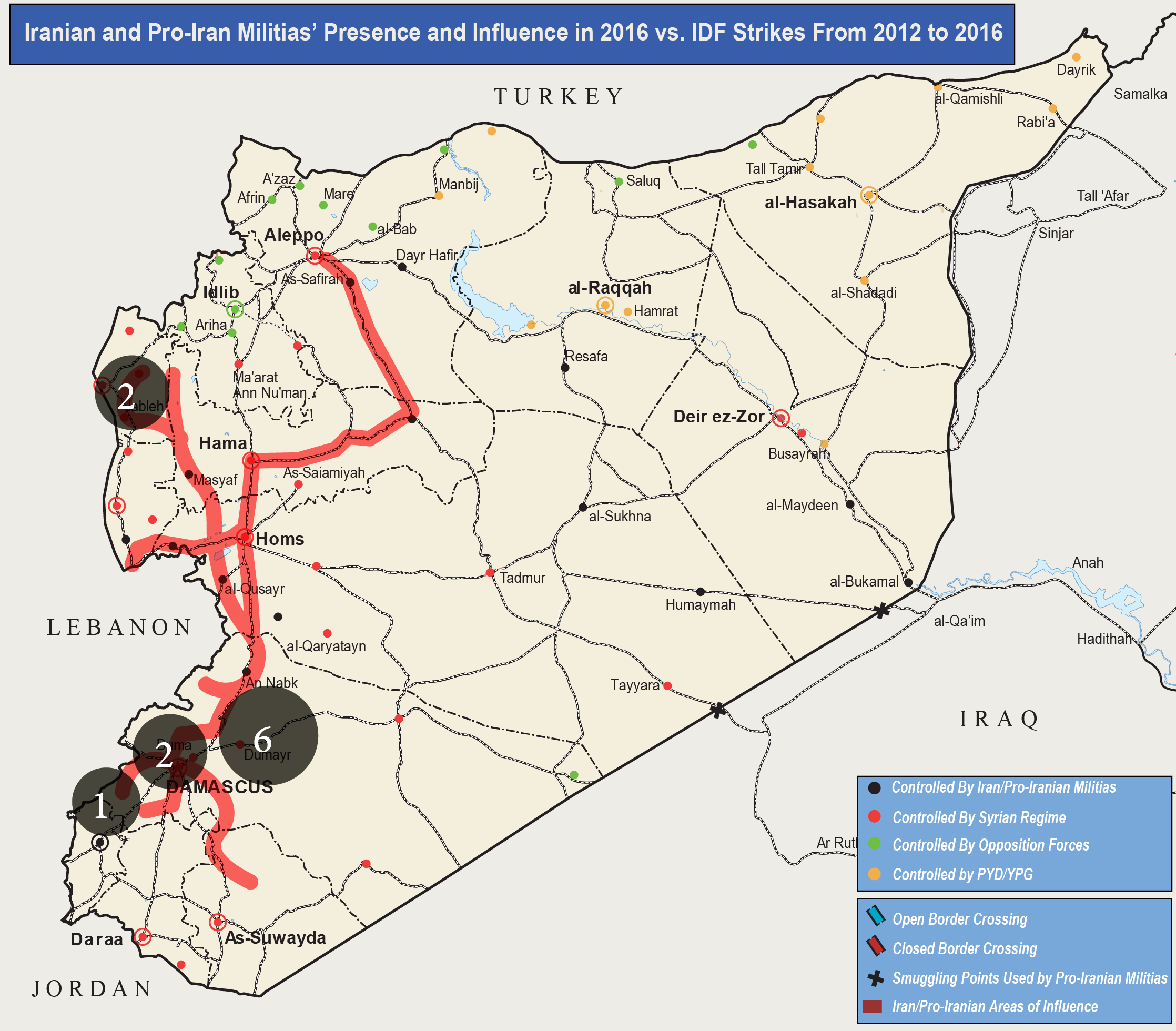
Analysis of Strikes and Influence from 2017 to 2023
As of 2017, Iran’s sphere of influence in Syria substantially grew from what it was at the close of 2016. Throughout the timeframe extending from 2017 to Aug. 31, 2023, Iran notably broadened its foothold in Syria, successfully establishing control over critical international roadways, numerous strategic land passages, and the pivotal airports of Damascus and Aleppo, alongside various military bases, and airstrips.
Upon scrutinizing the trajectory of Israeli airstrikes and the specific targets within Syria, a discernible post-2017 escalation in the Israeli offensive strategy is evident. While it might be a straightforward deduction to perceive this escalation as Israel’s intensified endeavor to counteract the Iranian initiative in the region, the underlying reality is somewhat different.
Iran was progressively venturing into new territories, a strategic move that essentially compelled Israel to amplify its airstrike campaigns and revisit its objectives in Syria. This period witnessed Iran not just consolidating its existing bases but also venturing into new strategic geographic areas, thereby necessitating a recalibrated approach from Israel to safeguard its interests.
Maps 2 and 3 provide a detailed graphical illustration of Iran’s and its militias’ areas of influence and control, from 2016 to August 2023. Additionally, these maps elucidate Israel’s strategic aerial bombardment approach, which was primarily centered on addressing the expanding centers of Iranian influence.
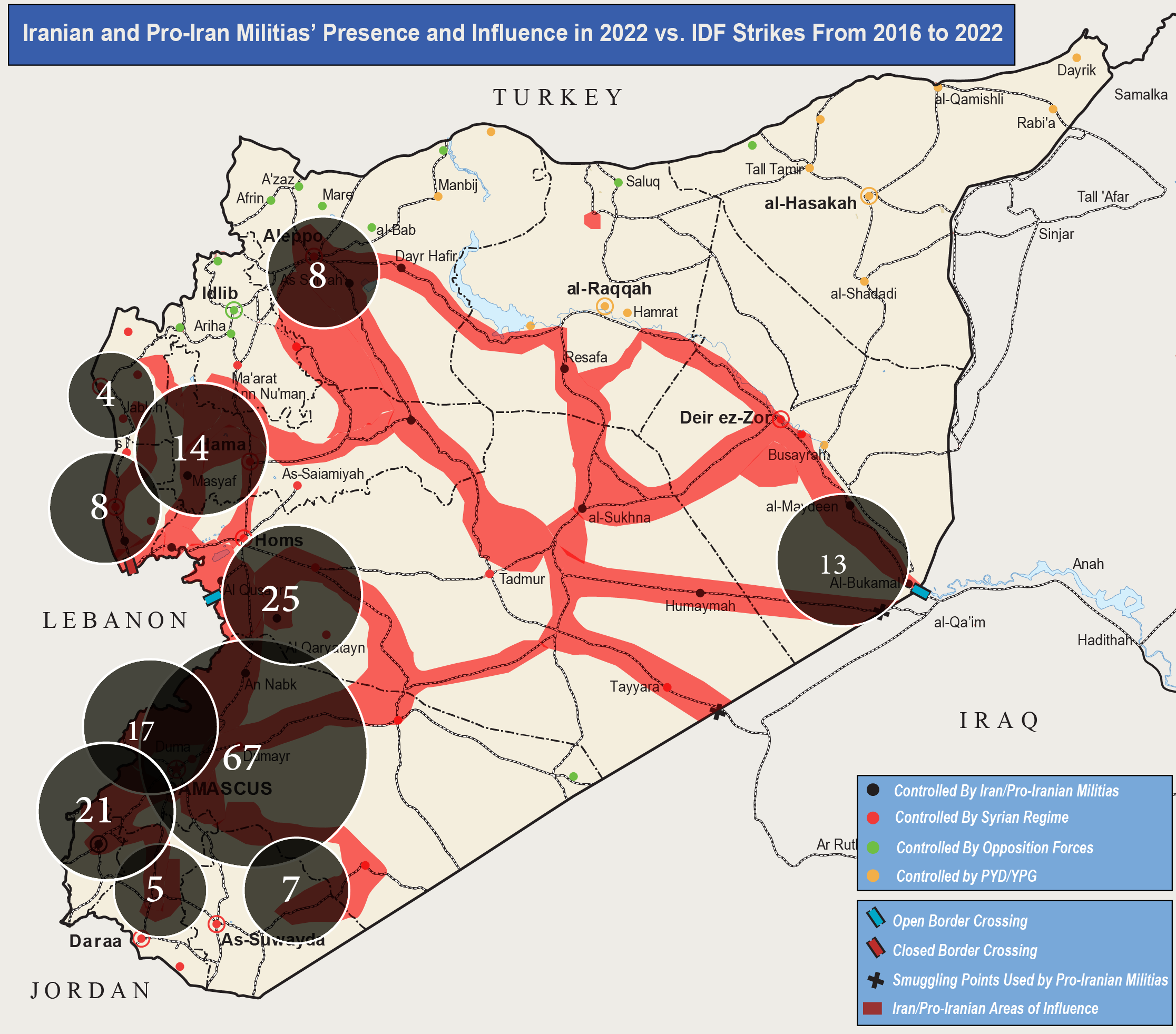
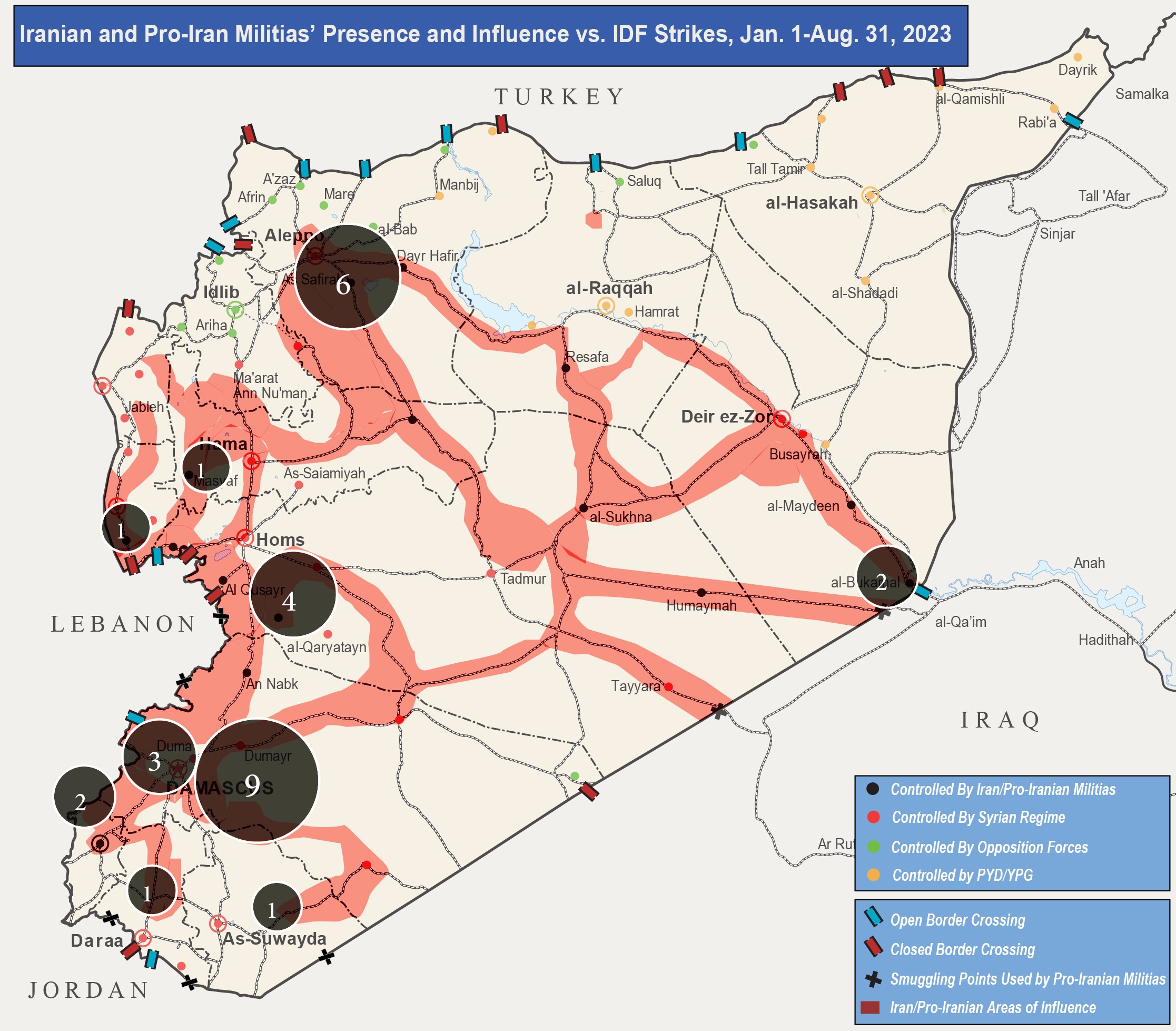
Analysis of Israeli Strikes Based on Temporal and Geographical Data
Between 2016 and mid-2023, Israel acknowledged it needed to address the burgeoning Iranian influence and territorial control in various regions of Syria. This period marked Israel’s (and the U.S.’s) strategic operations targeting 192 sites across 12 governorates that were known to harbor Iranian forces or affiliated militias. Of these operations, 13 were directed at Iranian strongholds in the Deir ez-Zor Governorate; however, these were executed by the U.S. forces, not by Israel.
A significant 61% of these Israeli operations were focused along Syria’s southern fronts. Intriguingly, this 61% can be dissected into two distinct time frames. The first spans from 2013 up to the point when the Russian-backed regime assumed control of the area. During this phase, the region was predominantly under the control of opposition forces, establishing a robust buffer zone that effectively thwarted potential Iranian threats. Consequently, Israeli strikes during this period accounted for a mere 8% of the total operations. In contrast, the second phase, from the Russian and Syrian regime takeover up to the present day, witnessed a surge in Iranian activities. The absence of the opposition’s buffer allowed Iran to operate with relative freedom in the region, leading to Israeli strikes constituting a staggering 52% of the overall operations. A straightforward mathematical analysis underscores the pivotal role the Syrian regime’s control over the southern regions played in facilitating Iran and its militias’ expansive influence in these areas. This control not only bolstered Iran’s military presence but also enabled it to deploy innovative control mechanisms, such as its “soft tools.” These strategies have allowed Iran to maintain dominance by leveraging various local instruments across different sectors.3
This strategic focus was driven by this area’s geographical proximity to Israel, which heightened the risk of threats to Israel’s national security from Iran and its allied militias. Those groups established a significant presence by seizing control over numerous local military bases and air-defense installations. Furthermore, they continue to exert control over critical land routes and airports in southern Syria, amplifying the security concerns for Israel.4
Tables 1 and 2 show the Israeli strikes in Syria by year, highlighting a period of minimal or limited Iranian activity from 2013 to 2017. Since then, the Iranian influence expanded, thus prompting an increase in Israeli strikes. As indicated in the tables, there was a significant surge in Israeli aerial attacks after 2017, reaching its peak in 2022 with a total of 48 targeted strikes on various locations in Syria. In 2023, from Jan. 1 to Aug. 31, Israel carried out 30 strikes, with half of them focused on the areas surrounding Damascus and the Aleppo International Airport.
This data reflects Israel’s adaptive strategic response to the growing Iranian influence in Syria, showcasing a commitment to protecting its national security through escalated efforts in recent years.
Table 1: Israeli Strikes by Year
Table 2: Israeli Strikes by Year and Governorate
Analysis of Israeli Strikes Based on Targeted Sites/Locations
Distribution of Israeli Strikes Based on Military Sites
Since 2011, Iran has intensified its military interventions in Syria, aiming to establish a dominant military presence and further its objective of achieving regional hegemony. This development stands as a direct threat not only to Israel but also to the broader region. Israel perceives this growing Iranian military footprint in Syria as a significant security concern. Consequently, it has been actively working to curb Iran’s military sway in various Syrian governorates, guided by a strategic approach in selecting specific targets. This initiative is grounded in Israel’s commitment to safeguarding its security and defending its regional interests. Over the past few years, Israel has focused its efforts on neutralizing potential threats emanating from military research centers located in Masyaf and Jamraya, which are believed to be pivotal to Iran’s endeavors to enhance its missile capabilities inside Syria.
The specific targeting of Syria’s military research centers by Israel over the past year is emblematic of a broader geopolitical strategy aimed at curbing Iran’s ambitions in the region. Central to this strategy is Israel’s determination to thwart Iran’s efforts to bolster its missile capabilities within Syrian borders. Historically, Israel has been vigilant about threats emanating from its immediate neighbors. The recent experiences in southern Lebanon, with Hezbollah, and in the Gaza Strip, with Hamas, have been instructive. In both regions, the adversaries were equipped with advanced missile systems capable of posing significant a threat to Israeli territory. In southern Lebanon, Hezbollah’s arsenal, believed to be supplied largely by Iran, has long-range missiles that can reach deep into Israel. Similarly, rocket attacks originating from Gaza underscored the persistent threat from advanced missile systems.
Given this backdrop, Israel’s actions in Syria can be viewed as a proactive measure to prevent the emergence of a third front where advanced missile systems, especially those enhanced by Iranian expertise, can pose a long-range direct threat. Targeting Syria’s military research centers, which are pivotal to the development of missile technology, can thus significantly impede Iran’s endeavors. The high recurrence of Israel’s sortie attacks on these sites suggests the goal was to disrupt these targets at specific junctures, thereby hindering the continuous progress of Iran’s missile projects.
This approach is not just about immediate defense but is also part of a long-term strategy. Israel aims to ensure that it doesn’t find itself encircled by regions under the control of advanced missile systems. Such a scenario would not only strain Israeli defense but also tilt the strategic balance in the region, potentially emboldening adversaries and escalating tensions.
Distribution of Israeli Strikes on the Coastal Governorates (Tartus and Latakia)
In 2022, Iran and its affiliated militias visibly expanded their influence along the Syrian coast, capitalizing on Russia’s diverted attention due to its engagement in the Ukraine invasion. This invasion necessitated a shift in Russia’s military strategy in Syria, altering its routine of quarterly personnel rotations between Syria and other active-duty locations. Consequently, Russia reconfigured its troop deployments within Syria, including a notable withdrawal from southern Syria to relocate forces to Tabqa, in Raqqa Governorate. These moves resulted in vacuums of control in southern, coastal, and central regions of Syria.
Seizing this opportunity, Iran swiftly moved to fill these vacuums, establishing a foothold to further its influence through “soft power tools.” Iran’s efforts were further bolstered following the Feb. 6, 2023, earthquake, a devastating disaster that affected many areas, including the Syrian coast. Leveraging its local allies, Iran facilitated aid distribution and established a service role in the region, understanding that the catastrophe could potentially remove barriers previously hindering its deployment along Syria’s coast.
Table 3 delineates the specifics of Israeli strikes aimed at locations either directly or indirectly linked to the Iranian presence in the Syrian coastal governorates. A significant portion of these strikes, 60%, targeted Tartus Governorate, with half of these focusing on air-defense sites in 2022.
Table 3: Israeli Targeting in the Coastal Governorates
Distribution of Israeli Strikes Based on the Targeted Airports
Since stepping into the Syrian conflict, Iran has aimed to secure control over various local airports, including both international and military facilities. However, Iranian presence at these locations has fluctuated over time, as reflected in the varying frequency of Israeli attacks on these airports. For instance, while 2016 saw no Israeli strikes on Syrian airports, 2018 experienced nine attacks on six different airports, including four military ones. A consistent focus of these strikes has been the al-Tayyas Airbase and Damascus International Airport.
Damascus International Airport holds strategic importance, serving a large number of passengers every year and facilitating flights to various cities within Syria and its neighboring countries. It has also served as a crucial point for Iran to supply its forces and support its ally, Hezbollah, in Lebanon. Over the past decade, this airport has been a primary target for Israel, with a significant increase in attacks in recent years, peaking in 2022.
Recognizing the recurrent targeting of the Damascus International Airport by Israel, Iran initiated a plan in 2022 to establish an alternative air-supply route. This led to the reopening of the Aleppo International Airport in February 2020, a move complemented by the inauguration of an Iranian consulate in Aleppo in May 2021. This strategy facilitated a secure channel for Iran to sustain its forces in Syria that avoids the heavily targeted Damascus route.
Furthermore, 2021 and 2022 marked a shift in the operational bases of several Iranian private companies from Damascus to Aleppo, indicating Iran’s growing emphasis on bolstering its presence in Aleppo through various means, including enhancing control over the Aleppo International Airport and increasing its military, security, political, and economic influence in the region.
Table 4 provides detailed data on Israeli strikes targeting international and military airports from 2013 to Aug. 31, 2023, offering a comprehensive view of the evolving dynamics in the region. What emerges from this data is evidence of strategic shifts and adaptations in Iran’s approach to maintaining its influence and operations in Syria amidst the ongoing conflict.5
Table 4: Strikes on International and Military Airports
In the initial months of 2023, Israel scaled back its operations, targeting fewer locations compared to previous years. However, the strikes that were carried out had a pronounced impact. Notably, on Jan. 2, 2023, Israel struck Damascus International Airport, rendering it non-operational for a full day.
Later in the first quarter, on March 7, 2023, Israel initiated an unprecedented strike on Aleppo International Airport. This attack was the first of its kind in 2023, and the first since the devastating earthquake on Feb. 6. The operation halted the airport’s services from March 7 to 10. These moves underscore that global developments have not swayed Israel’s determined approach to countering Iranian expansion in Syria. It is evident that Israel remains steadfast in its strategy to curb Iranian influence in the region, undeterred by shifting dynamics on the international stage.6
Summary of Findings
Since the commencement of its direct intervention in Syria, Iran has been actively striving to amplify and solidify its control and sway there. Tehran has delineated several strategic goals in Syria, the foremost being the establishment of a mutual border with Israel, leveraging the Syrian and Lebanese fronts. This endeavor involves safeguarding a conduit for military assistance to Hezbollah in Lebanon, sustaining the Syrian regime, and fostering its strategic aspirations in the region. In charting these Iranian expansionary activities and Israeli counter-measures, it is possible to conclude:
- Iran has been actively working to increase its influence and control in Syria since the beginning of its direct intervention in the region, with a primary goal of establishing a shared border with Israel through the Syrian and Lebanese fronts.
- Iran’s strategy in Syria includes supporting Hezbollah in Lebanon, maintaining the Syrian regime, and advancing its own regional strategic interests.
- Iran has been influencing the military and security institutions in areas controlled by the Syrian regime and has transformed Syria into a training ground for its foreign militias.
- Over the years, Israel has been proactive in its defense strategy, as evidenced by the numerous hits it has carried out on various targets within Syria. These targets have not been chosen at random; they are often locations with significant influence or presence of Iran and Hezbollah. Both entities are viewed by Israel as formidable adversaries with expansionist ambitions in the Middle East, and their growing foothold in Syria has been a cause for concern for Israeli defense and intelligence communities. The rationale behind these hits is multifaceted, by targeting these locations, Israel aims to disrupt the logistical and operational capabilities of Iran and Hezbollah in Syria. This includes hindering the transfer of advanced weaponry, obstructing the establishment of permanent military bases, and preventing the creation of a continuous land bridge from Iran to the Mediterranean, which could facilitate the movement of weapons, personnel, and resources.
- The frequency and intensity of Israel’s airstrikes have been directly proportional to the perceived level of threat. As Iran and Hezbollah have intensified their efforts to consolidate their positions in Syria, Israel has responded with increased vigor. For instance, when intelligence reports indicate the transfer of precision-guided missiles or other advanced weaponry, Israel has often acted swiftly to neutralize the threat. Similarly, any attempts by Hezbollah to establish a stronger presence near the Israeli-Syrian border have been met with decisive action.
- Israel’s airstrikes in Syria are a manifestation of its broader strategy to counter the growing influence of Iran and Hezbollah in the region. By acting preemptively and decisively, Israel aims to ensure that the balance of power does not tilt unfavorably and that its national security remains uncompromised.
- Between 2013 and Aug. 31, 2023, Israel carried out 226 strikes in Syria, with 172 clearly identified targets and 54 remaining unspecified. The primary objective of these strikes was to prevent Iran and Hezbollah from strengthening their positions and roles in the Syrian conflict.
- Iran is determined to expand its presence in Syria, showcasing its commitment to supporting the Syrian regime and sending a strong message to Israel, the U.S., and other countries. This involves enhancing its military position and missile capabilities in Syria.
- Considering efforts toward international rapprochement with the Syrian regime,7 particularly in the region, Iran may find itself needing to redefine its presence and control and rely more on its local allies in Syria.
- Given the significant military and security developments in the region, particularly following the Israeli conflict in the Gaza Strip, there is an increased need for more meticulous observation of the changing dynamics. It is crucial to understand Iran’s potential strategies in Syria, especially since Israel has explicitly indicated a shift in its rules of engagement in the region through its strikes on the Damascus and Aleppo airports. Israel justified those actions as a response to several mortar attacks from the Syrian side. However, the nature of those strikes differed from Israel’s previous responses, appearing more as a demonstration of Israeli military prowess. Such a robust response to a few mortar shells suggests that Israel’s intent was to showcase its capability to operate on multiple fronts, rather than merely a retaliation for the damage caused by the mortars.
About the Author
Navvar Şaban is a military and security expert at the Turkey-based Omran Center for Strategic Studies. He specializes in tools of Iranian influence in Syria and Iraq, focusing in particular on Shi’a militia activity. Şaban holds an MBA from the University of Wollongong in Dubai, a Bachelor of Computer Science degree from American University in Dubai, and Bachelor’s in International Relations and National Security Studies from Istanbul Sabahattin Zaim University.
Notes
1 The report clarifies the number of targets, whether they were Israeli air strikes or long-range missiles. However, the report does not clarify the number of strikes on a single target, which can result in a mismatch between the number of strikes cited below versus the number officially acknowledged by Israel.
2 The mechanism for obtaining information and locations was obtained using the following tools: an archive compiled by private researcher and expert in Syrian geography and geospatial positioning “Samir” (@obretix), the Israeli media, as well as Iranian jihadist sites that published photos of Islamic Revolutionary Guard Corps personnel killed in Syria.
3 The southern fronts of Syria span the governorates of As-Suwayda, Daraa, Quneitra, and Rural Damascus, as well as the city of Damascus.
4 Despite the multiplicity of sources regarding the monitoring of Israeli raids on Iranian sites in Syria, it was not possible to confirm the real purpose behind some Israeli strikes; initial reports suggested that these strikes were aimed at neutralizing certain military figures from the Iranian Revolutionary Guard Corps or from Lebanese Hezbollah. Most of these requests were in Damascus Governorate and Rural Damascus, in addition to the eastern countryside of Homs.
5 “إعادة تشغيل مطار حلب الدولي بعد توقفه لنحو 9 سنوات.. شاهد التفاصيل [Restarting Aleppo International Airport after it stopped for about 9 years.. See the details],” Al Ghad TV, YouTube, February 20, 2020, https://www.youtube.com/watch?v=24_YCCC2NU4; “Inauguration of the Iranian Consulate General in Aleppo,” SANA News, May 22, 2021, https://sana.sy/?p=1389254; “Opening of an Iranian Consulate in the Syrian City of Aleppo: Objectives and Implications,” Emirates Policy Center, June 22, 2021, https://epc.ae/ar/details/brief/aiftitah-qunsuliya-iiraniya-fi-madinat-halab-alsuwriya-alahdaf-waldalalat.
6 @obretix, “three of the four targets on the runway are patched craters from a previous strike exactly six months ago [sic],” Twitter, March 7, 2023, https://twitter.com/obretix/status/1633176118919323649.
7 Danny Makki, “Syria’s economic freefall continues despite Arab League return,” Middle East Institute, August 16, 2023, https://www.mei.edu/publications/syrias-economic-freefall-continues-despite-arab-league-return; Danny Makki, “The UAE paves way for Syria’s return to the Arab fold, but plenty of hurdles remain,” Middle East Institute, January 31, 2022, https://www.mei.edu/publications/uae-paves-way-syrias-return-arab-fold-plenty-hurdles-remain.
Additional Photos
Main photo: Syrian security forces members inspect a building damaged in a reported Israeli missile strike in Damascus on Feb. 19, 2023. Photo by LOUAI BESHARA/AFP via Getty Images.
Contents photo: A satellite image of a destroyed warehouse and storage buildings at Damascus International Airport that were struck by a reported military airstrike on May 4, 2013. Photo by DigitalGlobe via Getty Images.
The Middle East Institute (MEI) is an independent, non-partisan, non-for-profit, educational organization. It does not engage in advocacy, and its scholars’ opinions are their own. MEI welcomes financial donations, but retains sole editorial control over its work and its publications reflect only the authors’ views. For a listing of MEI donors, please click here.











